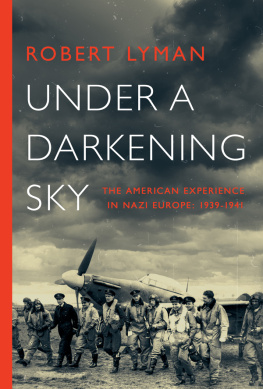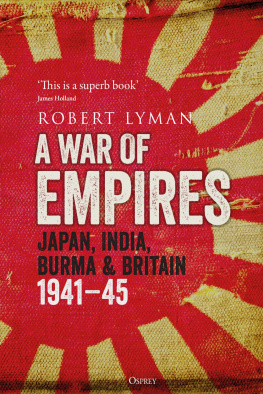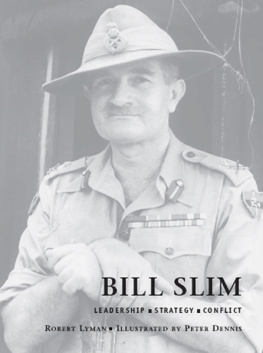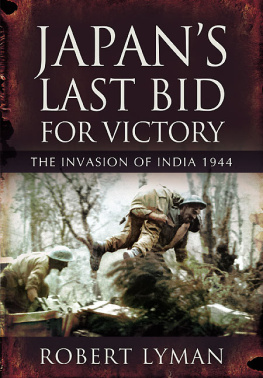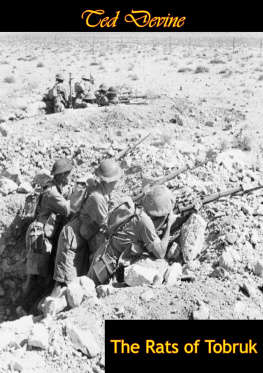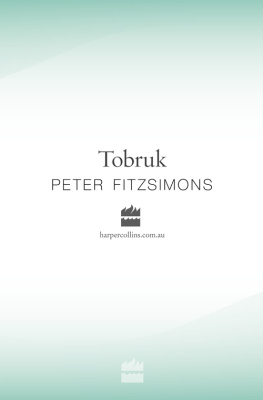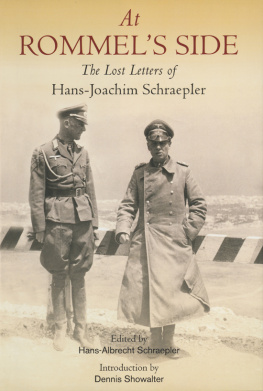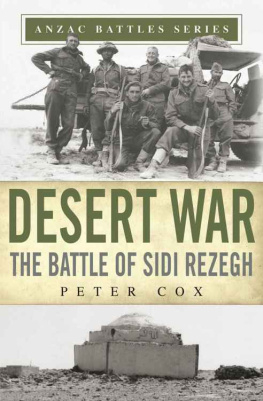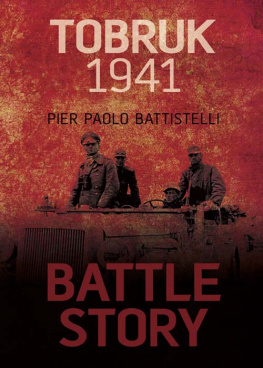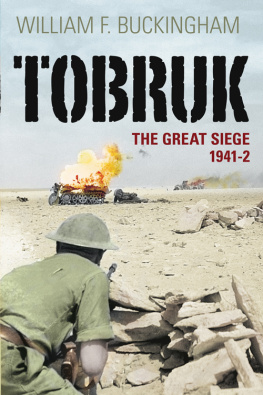Robert Lyman was for twenty years an officer in the British Army. Educated at Scotch College, Melbourne and the Royal Military Academy, Sandhurst, he has degrees from the Universities of York, Wales, London and Cranfield.
Also by Robert Lyman
Slim, Master of War: Burma and the Birth of Modern Warfare
Iraq 1941: The Battles for Basra, Habbaniya, Fallujah and Baghdad
First Victory: Britain's Forgotten Struggle in the Middle East
The Generals: From Defeat to Victory, Leadership in Asia 19411945

First published 2009 by Macmillan
First published in paperback 2010 by Pan Books
This electronic edition published 2010 by Pan Books
an imprint of Pan Macmillan, a division of Macmillan Publishers Limited
Pan Macmillan, 20 New Wharf Road, London N1 9RR
Basingstoke and Oxford
Associated companies throughout the world
www.panmacmillan.com
ISBN 978-0-230-74112-6 PDF
ISBN 978-0-230-74111-9 EPUB
Copyright Robert Lyman 2009
The acknowledgements on page vi constitute an extension of this copyright page.
The right of Robert Lyman to be identified as the author of this work has been asserted by him in accordance with the Copyright, Designs and Patents Act 1988.
You may not copy, store, distribute, transmit, reproduce or otherwise make available this publication (or any part of it) in any form, or by any means (electronic, digital, optical, mechanical, photocopying, recording or otherwise), without the prior written permission of the publisher. Any person who does any unauthorized act in relation to this publication may be liable to criminal prosecution and civil claims for damages.
A CIP catalogue record for this book is available from the British Library.
Visit www.panmacmillan.com to read more about all our books and to buy them. You will also find features, author interviews and news of any author events, and you can sign up for e-newsletters so that youre always first to hear about our new releases.
For Philip and Isla Brownless
Photographic Acknowledgements
Getty Images: (Hulton Archive)
Corbis:
Imperial War Museum: (E6442)
Australian War Memorial: (011006),
AP/PA Photos: , 39
Contents
Acknowledgements
This book is dedicated to the Reverend Philip Brownless, a veteran of the siege and whose original idea this book was, and his indefatigable wife, Isla, whose extraordinary capacity for editing has been a serious loss to the publishing industry.
I wish to thank the many people who made this book possible. In no particular order they include Ben Brownless (Philip and Isla's son), who accompanied me to Tobruk; Lieutenant General A.D. Leakey CMG CBE; Mr Roderick Suddaby and the staff at the Imperial War Museum Department of Documents; the staff of the Liddell Hart Archives at my alma mater, King's College, London; the staff at the British Library and the National Archives, Kew; Major George Burns; Colonel Andrew Duncan; veterans Major R.G. Holmes MM, Peter (and Mrs) Cochrane, Frank Harrison, Alex Franks, Tom Swallow, Jack (and Mrs) Senior, Peter Bindloss and Alec Clarke; authors Colin Smith and Ian W. Walker; Hilary Pethick (for translating German texts); and Mrs Caroline Davies (for translating Italian texts).
In the United States I was assisted by veterans the Reverend Christopher Morley and Zbigniew Wolynski, and Mr Peter Guinta; in New Zealand by Alan Gray and Martyn Thompson. In Libya I wish to thank Mr Sami el-Gibany and his son Muhammad, who eased my way around the battlefield, as did Mr Abdelghader Awad Imzainy in Tobruk and the local historian Mr Fadeel Altaib, son of the Tobruk postmaster during the siege; Mr Muhammad Haneesh, keeper of the war graves in Tobruk and battleield guide; and Professor Dr Fadhl Ali Muhammad, keeper of antiquities in Cyrenaica. In Germany I am grateful to Bernd Peitz; Rudolf Schneider, who served with Rommel's personal battle squadron, and to Klaus and Elke, his son and daughter-in-law respectively, for their warm hospitality during my visits to Germany; and to veterans Hans Werner Schmidt, Rolf-Werner Volker and Rolf Munniger.
In Australia I wish to thank my brother Bruce Lyman, Colonel Bob Breen; the Australian War Memorial, Canberra; the Oral History Collection, National Library of Australia, Park, Canberra; Eddie Marlowe; the Polish Carpathian Brigade veterans Marian Jackiewicz and Mietek Drelich; Barry York; Kristen Alexander and Alexander Staunton of the Military History Society of Australia. I am particularly grateful for the help received from Major General Gordon Maitland AO OBE RFD ED (RL), who set me right on more than one issue and was a supportive though challenging correspondent.
I wish to acknowledge the following authors and publishers for permission to quote from their works: Peter Cochrane for Charlie Company; Constable and Robinson Ltd for Take These Men by Cyril Joly and With Rommel in the Desert by Heinz Schmidt; Christopher Somerville for Our War: How the British Commonwealth Fought the Second World War; Martyn Thompson for Our War: The Grim Digs. New Zealand Soldiers in North Africa, 194043; Frank Harrison for Tobruk; Don West for Warriors in the Know; Colin Smith for War without Hate; Lieutenant General David Leakey for Leakey's Luck by his father, Major General Rea Leakey; Paul Carell for The Foxes of the Desert (Die Wstenfchse, Hamburg, 1961); Alex Franks for his delightful conversations and his unpublished memoir Non Combatant; Angus and Robertson (Sydney) for permission to quote from Chester Wilmot's Tobruk, 1941 and John Devine's The Rats of Tobruk; Susan Travers Tomorrow Be Brave; Ian W. Walker for Iron Hulls, Iron Hearts; Weidenfeld and Nicholson for Robin Neillands The Desert Rats; David Irving for The Trail of the Fox; HarperCollins for Basil Liddell Hart's The Rommel Papers; William Heinemann for the Countess of Ranfurly for To War With Whitaker; Frank Harrison for Tobruk: The Birth of a Legend; and Cassel and Company for Alan Moorehead's African Trilogy.
To the Imperial War Museum, London, and individual copyright holders I am grateful for the use of the following material: W.A. Lewis (88/60/ 1); R.L. Braithwaite (87/6/1); L.A. Passfield (87/29/1); B.R. Thomas (90/26/1); E.G. Porter (82/32/1); A.C. Collins (92/1/1); H. Atkins (92/28/1); B.R. Cowles (93/6/1); R.K. Ellis (PP/MCR/388); A.O.C. McGinlay (93/11/1); A. St Clair-Ford (PP/MCR/365); S.D.H.D. Wallis (91/8/1); F.D. Franks (PP/MCR/351); W.J. Green (91/16/1); S.C. Hankinson (91/16/1); J.A.J. Dennis (95/5/1); L.E. Tutt (85/35/1); D. Prosser (Con Shelf); R.B.T. Daniell (67/429/12); C.F. Shaw (67/261/1); R.A. Grimsey (78/52/1); C.M.S. Gardner (99/23/1); J.H. Parker-Jones (01/10/1); J.E.G. Quinn (P247); J.W. Kelly (P469); J.S. Parish (04/31/1); P.J. Hurman (99/85/1); H. Wiles (06/99/1); P. Cleere (67/279/1); Lamb (86/11/1); Pleydell (90/25/1); Owen (95/2/1); T. Stephanides; and H.L. Sykes.
To the BBC and individual copyright holders for use of the People's War archive, 20046: Tom Barker (ID A1904258); Walter Drysdale (ID A4441231); Preston John Hurman (ID A2057032); Reginald Copper (ID A4513268); David Boe (ID A3894771); Bill Harvey (ID A4569096); Bob Borthwick (ID A4544101); Alan Jones (ID A4544011); Richard Hill (IDA2051236); and Graeme Sorley(ID A2270549).
To the Australian War Memorial, Canberra and individual copyright holders, for material from the following records: PRO 0603 (16 Infantry Brigade Papers); MSS 1658 (Richard Stanton); PR91/190 (20 Infantry Brigade); PRO 0213 (Neville Parramore); MSS 1545 (D Company, 2/13th Battalion); PRO0667 (John Johnson); MSS 0868 (Frank Rolleston); PRO 0339 (Michael Kelly); PR85/250 (Francis Gorman); PR88/125 (Rowland Bourke); PR84/113 (Kevin Thomas); PR84/163 (Ron Grant); PR83/002 (W Fitzgerald); PR83/138 (David West); PRO 0186 (Andrew Nation); PRO 0303 (H Hennessey); PRO 0434 (W Bradbury); PRO 0508 (M. Chalmers); PRO 0548 (James Liddiard); PRO 0574 (Unknown Sailor); PRO 0570 (2/12th Battalion); MSS 1572 (John Haslam); PRO 0656 (Francis Pinwell); MSS 1656 (Philip Hurst); PRO 0809 (Les Perkins); PRO 1328 (Gordon Grainger); PRO 1362 (Norman Ericson); PRO 1770 (James Eagleton); MSS 1605 (Frank Pervsersi); PRO 0231 (Bayne Geikie); MSS 1587 (Leslie Watkins); MSS 1604 (Gavin Keating); and PRO 2055 (Cecil Greenwood).
Next page

